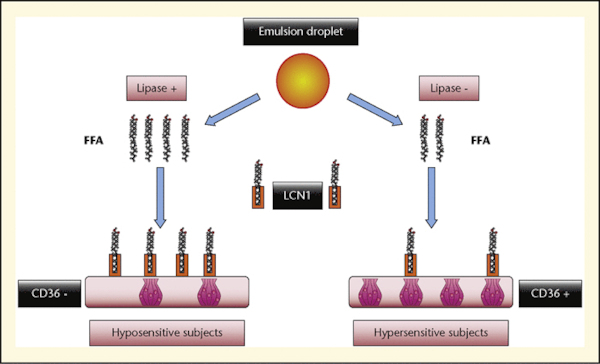Figure 1.

Download original image
Schematic representation of the causal hypothesis formulated from the different correlations observed between fat taste sensitivity and saliva composition (Pepino et al., 2012; Poette et al., 2012). In this hypothesis, the level of free fatty acids detected is regulated by lipolysis activity against the emulsion droplet. In hyposensitive subjects, a high level of lipolysis is necessary to release a sufficient amount of free fatty acids from the emulsion to be detected. The solubilisation of the fatty acids is regulated by LCN1, which is not a limited component in this case. Considering the conclusion from Pepino’s work (Pepino et al., 2012), hyposensitive subjects also express low levels of CD36 receptors. In hypersensitive subjects, the threshold amount of free fatty acids necessary to be detected is considerably lower, explaining the low level of lipase observed in these subjects. Moreover, higher CD36 expression permits a better detection of the FFAs released from the lipolysis activity. FFA = free fatty acid, LCN1 = lipocalin 1.
Current usage metrics show cumulative count of Article Views (full-text article views including HTML views, PDF and ePub downloads, according to the available data) and Abstracts Views on Vision4Press platform.
Data correspond to usage on the plateform after 2015. The current usage metrics is available 48-96 hours after online publication and is updated daily on week days.
Initial download of the metrics may take a while.




